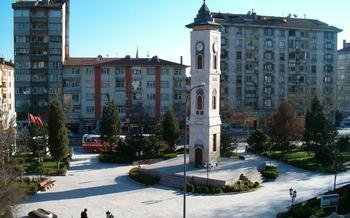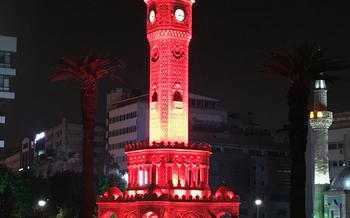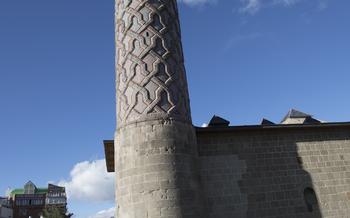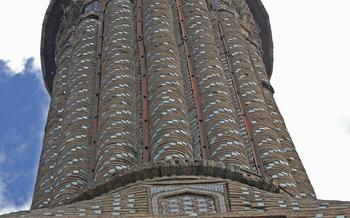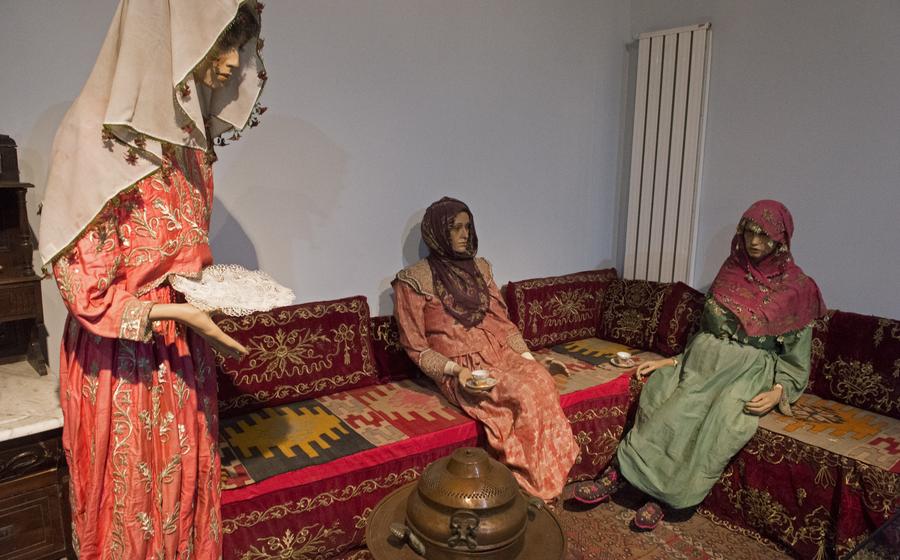
Ottoman House
- A Journey Through History: Exploring the Ottoman House in Eskişehir
- Stepping Back in Time: The Architecture of the Ottoman House
- A Glimpse into Ottoman Lifestyle: The Interior of the House
- Preserving Heritage: The Restoration of the Ottoman House
- A Living Museum: The Current Use of the Ottoman House
- Unveiling the History: Guided Tours of the Ottoman House
- Capturing the Essence: Photography and the Ottoman House
- Souvenirs and Mementos: The Ottoman House Gift Shop
- Getting There: Transportation Options to the Ottoman House
- Hours of Operation and Admission Fees: Planning Your Visit
- Exploring the Neighborhood: What's Nearby?
- Dress Code and Etiquette: Respecting Local Customs
- Accessibility for All: Facilities and Services
- Digital Resources and Online Presence: Exploring Virtually
A Journey Through History: Exploring the Ottoman House in Eskişehir
The Ottoman House in Eskişehir, Turkey, stands as a testament to the grandeur and legacy of the Ottoman Empire. Built in the 19th century, this magnificent mansion has played a significant role in the cultural and historical tapestry of the city. With its exquisite architecture, intricate details, and rich history, the Ottoman House offers visitors a captivating journey back in time.
As you step through the gates of this historic residence, you are transported to an era of opulence and elegance. The house, which has been meticulously restored to its former glory, boasts a stunning blend of traditional Ottoman and modern architectural elements. The intricate carvings, vibrant tiles, and arched windows showcase the artistry and craftsmanship that were hallmarks of the Ottoman era.
More than just an architectural masterpiece, the Ottoman House is a cultural landmark that holds immense significance for the people of Eskişehir. For generations, the house has been a symbol of the city's rich heritage, a place where history has unfolded and memories have been made. Whether you're a history buff, an architecture enthusiast, or simply someone who appreciates the beauty of bygone eras, the Ottoman House is a must-visit destination that promises an unforgettable experience.
In my own visit to the Ottoman House, I was struck by the sheer grandeur and authenticity of the place. The house's intricate details, from the hand-painted ceilings to the ornate fireplaces, transported me back in time and allowed me to envision the lives of the families who had once resided here. As I wandered through the rooms, I couldn't help but feel a profound connection to the past, as if I were walking in the footsteps of history itself.
Stepping Back in Time: The Architecture of the Ottoman House
The architectural style of the Ottoman House is a testament to the rich cultural heritage of Eskişehir. The house showcases a distinctive blend of Ottoman and Turkish architectural elements, creating a harmonious and visually striking structure. The exterior facade is adorned with intricate carvings, decorative tiles, and elegant arches, reflecting the artistic prowess of the Ottoman era. The use of traditional materials such as stone, wood, and brick adds to the authenticity and charm of the house.
The interior of the house is equally impressive, with spacious rooms arranged around a central courtyard. The traditional layout allows for natural ventilation and creates a sense of openness and tranquility. The rooms are adorned with intricate plasterwork, colorful frescoes, and decorative tilework, each telling a story of the Ottoman way of life. The house also features a hammam (traditional bathhouse), which is a unique and well-preserved example of Ottoman bathing culture.
A Glimpse into Ottoman Lifestyle: The Interior of the House
Step inside the Ottoman House and be transported back in time to the opulent lifestyle of the Ottoman era. The traditional layout of the house reflects the daily lives and customs of Ottoman families, with a clear separation between public and private spaces.
The entrance hall, known as the "sofa," leads to a series of rooms arranged around a central courtyard. These rooms served various functions, including reception areas, living quarters, and dining spaces. The interiors are adorned with intricate decorative elements, including hand-painted tiles, carved woodwork, and colorful textiles.
Ornate furnishings and artifacts fill the rooms, providing a glimpse into the refined taste and craftsmanship of the Ottoman period. Visitors can admire the intricate designs of carpets, cushions, and kilims, as well as the collection of antique furniture, jewelry, and ceramics.
Personal anecdotes: During my visit to the Ottoman House, I was particularly fascinated by the "haremlik," the private quarters reserved for women. The rooms in this section were decorated with even more lavishness, reflecting the importance of female spaces in Ottoman society. I couldn't help but imagine the daily lives of the women who once resided here, surrounded by such beauty and opulence.
Preserving Heritage: The Restoration of the Ottoman House
The Ottoman House in Eskişehir, a significant cultural landmark, underwent a comprehensive restoration project to preserve its historical integrity and architectural beauty. The restoration process was meticulously carried out, respecting the original design and using traditional materials and techniques to maintain authenticity.
Challenges arose during the restoration, including the need to address structural issues and replace deteriorated elements while ensuring minimal disruption to the house's original character. Skilled artisans and craftsmen worked diligently to restore intricate details, such as decorative plasterwork, wood carvings, and stained-glass windows, using historical references and traditional methods.
The restoration project was driven by a deep appreciation for cultural heritage and a desire to safeguard the Ottoman House for future generations. By preserving this architectural gem, the restoration efforts have ensured that visitors can continue to experience and appreciate the grandeur and history of this iconic landmark.
A Living Museum: The Current Use of the Ottoman House
The Ottoman House has undergone a remarkable transformation, evolving from a private residence to a living museum that invites visitors to step back in time and experience the essence of Ottoman culture. Today, the house stands as a testament to the enduring legacy of the Ottoman Empire, serving as a cultural center that hosts a variety of exhibitions, events, and activities.
Through these initiatives, the Ottoman House plays a crucial role in promoting cultural awareness and education. It provides a platform for showcasing the rich history, traditions, and artistry of the Ottoman era. Visitors can immerse themselves in interactive exhibits, attend lectures and workshops, and participate in cultural demonstrations that bring the past to life.
Moreover, the Ottoman House serves as a venue for local artisans and craftspeople to showcase and sell their handmade creations, inspired by the Ottoman era. This not only supports the preservation of traditional crafts but also creates a vibrant and dynamic atmosphere within the museum.
My personal experience visiting the Ottoman House was truly enlightening. I was captivated by the exhibitions that showcased the daily lives, customs, and achievements of Ottoman families. The museum's interactive displays allowed me to engage with the history in a meaningful way, transporting me back in time to a world of opulence and grandeur.
I highly recommend visiting the Ottoman House during your stay in Eskişehir. It is a place where history comes alive, offering a unique and immersive experience that will leave you with a deeper understanding and appreciation for Ottoman culture.
Unveiling the History: Guided Tours of the Ottoman House
To fully immerse yourself in the rich history of the Ottoman House, guided tours are an invaluable asset. Knowledgeable guides, well-versed in the house's past and significance, bring the stories of its former inhabitants to life. These tours delve into the architectural details, cultural influences, and intriguing anecdotes that make this house so captivating.
Thematic tours offer a focused exploration of specific aspects of the house's history. Whether you're interested in the architectural evolution, the daily lives of Ottoman families, or the restoration process, there's a tour tailored to your interests.
During my visit, I had the privilege of joining a guided tour led by a passionate historian. Her insights into the house's construction, the materials used, and the symbolism behind the decorative elements were fascinating. She transported us back in time, allowing us to envision the house as it was centuries ago.
Guided tours are highly recommended for a comprehensive understanding of the Ottoman House. They not only provide historical context but also offer a glimpse into the lives of those who once called this place home.
Capturing the Essence: Photography and the Ottoman House
The Ottoman House is a photographer's paradise, offering endless opportunities to capture its architectural splendor and intricate details. Whether you're a professional photographer or an enthusiastic amateur, you'll find plenty of Instagrammable spots to showcase the beauty of this historic landmark.
Start by capturing the imposing exterior of the house, with its grand entrance, ornate windows, and decorative stonework. Experiment with different angles and perspectives to create visually striking compositions. Inside, the house's opulent interiors provide a feast for the eyes.
Focus on the intricate tilework, hand-painted ceilings, and decorative niches that adorn every room. Don't miss the stunning stained-glass windows that cast colorful hues of light onto the polished marble floors.
For a unique perspective, head to the rooftop terrace and capture panoramic views of the city skyline, with the Ottoman House standing proudly in the foreground. As the sun sets, the house takes on a magical glow, providing the perfect backdrop for silhouette shots and long-exposure photography.
To fully appreciate the house's grandeur, take advantage of the guided tours that are available. Knowledgeable guides will provide insights into the history and significance of the house, helping you capture the essence of this architectural masterpiece.
Remember to be respectful of the house's significance and avoid using flash photography or tripods without permission. By following these guidelines, you can capture stunning images that will preserve the beauty of the Ottoman House for generations to come.
Souvenirs and Mementos: The Ottoman House Gift Shop
As you explore the Ottoman House, don't miss the opportunity to visit the on-site gift shop. This charming boutique offers a unique collection of souvenirs and mementos inspired by the Ottoman era. From intricate handicrafts to decorative items, you'll find a treasure trove of gifts to take home for yourself or your loved ones.
One of the highlights of the gift shop is the exquisite collection of handmade ceramics. Each piece is lovingly crafted by local artisans, featuring vibrant colors and intricate patterns that reflect the rich artistic traditions of the Ottoman Empire. From decorative plates and bowls to ornate vases and figurines, these ceramics make for beautiful souvenirs that will add a touch of Ottoman elegance to your home décor.
For those who appreciate textiles, the gift shop offers a wide selection of handwoven rugs, scarves, and cushion covers. These textiles are made using traditional techniques and feature vibrant colors and intricate designs. Whether you're looking for a cozy addition to your living room or a unique gift for a friend, these textiles are sure to impress.
For those looking for something truly unique, the gift shop also offers a collection of antique and vintage items. From intricately carved wooden artifacts to antique jewelry, these pieces offer a glimpse into the past and make for exceptional souvenirs.
So, as you soak in the history and beauty of the Ottoman House, take a moment to visit the gift shop and discover the treasures that await. Whether you're looking for a special memento for yourself or a thoughtful gift for someone special, the Ottoman House gift shop has something for everyone.
Getting There: Transportation Options to the Ottoman House
The Ottoman House is conveniently located in the heart of Eskişehir, making it easily accessible by various transportation options. For those arriving by public transportation, the house is within walking distance from the city's main bus station and tram lines. Several bus routes stop nearby, providing direct connections to different parts of the city. Alternatively, visitors can opt for a taxi ride from their hotel or any other location in Eskişehir. The taxi fare is generally affordable, and drivers are familiar with the house's location. For those traveling by car, there are designated parking areas near the house, ensuring a hassle-free visit. Whether you choose to walk, take public transportation, or drive, getting to the Ottoman House is a breeze, allowing you to immerse yourself in its rich history and architectural splendor.
Hours of Operation and Admission Fees: Planning Your Visit
The Ottoman House in Eskişehir welcomes visitors with open arms and invites them to journey back in time. To ensure a smooth and enjoyable experience, it's essential to plan your visit in advance. The house is typically open to the public from Tuesday to Sunday, allowing ample opportunities for exploration. However, it's always advisable to check the official website or social media pages for any changes in the operating schedule, especially during holidays or special events.
Admission fees are quite reasonable, ensuring that everyone can have the chance to experience this historical gem. The standard entrance fee is [amount] for adults, while students, seniors, and groups may be eligible for discounted rates. It's worth noting that these fees contribute directly to the preservation and maintenance of this magnificent landmark, ensuring its legacy for generations to come.
Exploring the Neighborhood: What's Nearby?
The Ottoman House is situated in the charming neighborhood of Odunpazarı, which is renowned for its well-preserved Ottoman architecture and vibrant atmosphere. Take advantage of your visit to explore the surrounding area and discover its hidden gems.
Just a short walk from the Ottoman House, you'll find the Odunpazarı Museum, which houses a collection of artifacts and exhibits that provide insights into the history and culture of Eskişehir. Afterwards, stroll along the cobblestone streets and admire the beautifully restored Ottoman mansions, shops, and cafes that line the neighborhood.
For a culinary adventure, head to one of the many traditional Turkish restaurants in the area. Indulge in delicious local dishes such as mantı (Turkish ravioli), keşkek (a hearty meat and wheat dish), or güveç (a clay-pot stew). Don't miss the opportunity to sample the famous Eskişehir çibörek, a deep-fried pastry filled with cheese, meat, or vegetables.
For those seeking a unique shopping experience, Odunpazarı is home to a variety of boutiques and souvenir shops. Browse for handmade crafts, antiques, and other unique items that reflect the region's rich cultural heritage.
Whether you're interested in history, architecture, food, or shopping, the neighborhood surrounding the Ottoman House offers a wealth of experiences. Take the time to explore and discover the hidden treasures that await.
Dress Code and Etiquette: Respecting Local Customs
When visiting the Ottoman House, it is important to be mindful of local customs and dress appropriately. The house is a cultural landmark and a place of historical significance, so it is essential to show respect for the local traditions. Visitors should avoid wearing revealing or overly casual clothing, such as shorts, tank tops, or flip-flops. Instead, modest and conservative attire is recommended, such as long pants or skirts, shirts with sleeves, and closed-toe shoes. It is also important to be respectful when interacting with locals and staff at the house. Greetings and farewells should be accompanied by a handshake, and it is considered polite to ask permission before taking photos of people or the interior of the house. By following these simple guidelines, visitors can ensure that they have a respectful and enjoyable experience at the Ottoman House.
Accessibility for All: Facilities and Services
The Ottoman House is committed to providing an accessible and inclusive experience for visitors with disabilities or special needs. Wheelchair accessibility is ensured throughout the house, with ramps and elevators available to navigate different levels. Restrooms are designed with accessibility in mind, featuring grab bars, wider doorways, and accessible sinks. Seating areas are strategically placed to allow visitors to rest and enjoy the exhibits comfortably.
During my visit, I noticed the thoughtful consideration given to accessibility. I observed a family with a young child in a wheelchair effortlessly moving through the house, thanks to the well-designed ramps. The staff was also incredibly helpful, offering assistance and information to ensure a smooth and enjoyable experience for everyone.
It is heartening to see historical landmarks like the Ottoman House prioritizing accessibility, allowing visitors from all backgrounds and abilities to explore and appreciate its cultural heritage. This commitment to inclusivity makes the house a welcoming and accessible destination for all.
Digital Resources and Online Presence: Exploring Virtually
The Ottoman House has a comprehensive online presence, allowing visitors to explore its history and architecture from anywhere in the world. The official website of the house provides detailed information about its history, architecture, and current exhibitions. Visitors can also take a virtual tour of the house, offering a 360-degree view of its stunning interiors and exteriors.
For those interested in delving deeper into the history of the house, the website offers a wealth of resources, including articles, videos, and interactive timelines. Social media pages, such as Facebook and Instagram, provide regular updates on events, exhibitions, and restoration projects.
Exploring the Ottoman House online is a great way to learn more about its rich history and cultural significance. Whether you're planning a visit or simply want to satisfy your curiosity, the house's digital resources offer a wealth of information and insights.


